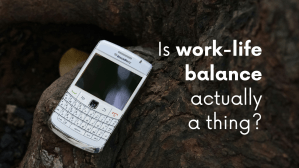“If the Holy Spirit left the earth today, how long would it take you to notice?”.
I admit, I don’t remember many of the thousands of sermons I’ve heard over the years, but this question posed in a sermon years ago has stuck with me and has often helpfully driven me to self-examination and prayer. But over the last few months, a similar question has started to bother me: “If your team stopped doing more than was absolutely essential, how long would it take you to notice?”
In the last couple of years, the term “quiet quitting” has emerged in HR and employment conversations (as well as on TikTok… a lot). The concept is that you don’t actually leave your job, you just stop doing anything more than is absolutely required of you. It’s moved from an observation of what was happening after the pandemic to an ideological stand for some folk: “Why should I put in extra effort? It’s up to my manager to inspire me, to invest in me and to develop me for for my next role.”
Last week, we looked at whether work-life balance was a thing. If the issue of stress and hurry is the result of staff being over-engaged, at the cost of their personal and sometimes spiritual lives, then quiet quitting is the issue we face on the other end of the scale when staff are under or disengaged (sometimes as a result of not figuring out the former issue!). For LDHR, one of the underlying issues is often the same for both situations. We generally operate in cultures that are high-trust. We have team meetings and check-ins, but for many of us, they are light-touch. We know that we have self-motivated staff members who can work well on their own. And it works well for us – I’ve never met a staff member who said, “I wish I was a bit more micro-managed”. Historically this has led to many team leaders just not seeing it coming when team members burn out from taking on more than God calls them to. But the issue emerges at the other end of the scale when staff are disengaged, doing the bare minimum: just enough to not get into trouble. In roles where much of the work is in taking the initiative, it becomes easy to hide and drift through.
“But we have highly committed staff who have made sacrifices for the sake of the mission”, I hear you say. “Surely this is not a problem for us?”
Each year, Gallup publishes their “State of the Global Workplace” report. Last year’s report revealed that 23% of the workforce were thriving, 18% were “loud quitting” (being actively disruptive and undermining the organisation) but 59% of the world’s employees were quietly quitting. They are psychologically disconnected from their employer and, ironically, are more likely to be stressed than engaged workers because they feel lost and disconnected from their workplace.
"59% of the world's employees are quietly quitting"
It’s easy to think that we are different and that the statistics don’t apply to us. But the factors that have led to this globally in employment are common to us all at times – stress, disillusionment, friction and boredom. It may be a slower-burn for our staff members, who typically have a much higher level of commitment than the average worker does to their job, but that may actually exacerbate the issue: it takes us as leaders and LDHR professionals longer to notice it.
And if it takes us longer to notice, the effects of this behaviour are not just damaging to our effectiveness as a movement; they are increasingly damaging to the staff member. Gallup reported that stress, anger levels, and worry tend to be higher in disengaged staff than they are for those that are unemployed! In contrast, “high-engagement business units” are likely to see 21% less turnover and 70% higher employee wellbeing.
So what can we do? Of those employees surveyed by Gallup, 41% identified culture and engagement issues (recognition for their contributions, development opportunities, respect, fair and open promotion opportunities and clearer goals) and 16% directly identified wellbeing issues (communicating change early, slowing the pace, having “down time” with other staff) as the key factors in making things better, so maybe some of those factors directly resonate with your experience.
LDHR have, for many years, talked about our staff being “known, needed and having a future”. This is never more relevant and needed than today. The process of engaging staff members can often be a highly individualised process. Engagement is more than just happiness and contentment. It’s about being psychologically & spiritually present, understanding what you need to do and having the resources to do it. Having a supportive leader and a supportive team and seeing the link between what you do and fulfilling the Great Commission. All that is a BIG challenge for LDHR, but here are a few things that we know we can provide:
- A role (as well as a calling) that gets them out of bed in the morning. If your ministry’s Position Focus conversations have got bogged down in form-filling, now might be the time to re-energise the conversations. Do the staff members spend the majority of their time in activities that energise them, or is it time to look at different responsibilities or roles within your staff team? (Heads-up – For those within the CCCI family, there’s a new Global Job Board coming soon!!)
- A pandemic approach to care and listening. Remember the early days of the pandemic when we all spent good time checking in with our staff to make sure they were doing OK? Maybe there was something in that time for us now. See what might be worth gleaning from these three conversations.
- “Giving them a better Manager”. This was the central application point from the Gallup report’s Executive Summary – If supervisors are motivated, engaged and flourishing, team members are far more likely to be. How can we invest in, encourage and support our local team leaders? How can we coach them to coach others better? You may have your own team-building resources in your country, but within the CCCI family, the Building Powerful Ministry Teams suite of diagnostics and resources has had an incredible impact. The LDHR Llama can point you in the right direction (see the Global LDHR Workplace group if you haven’t already got the Llama’s details)
Where have you seen quiet quitting emerging? How else have you approached the issue? As always, these are just some of my first thoughts, but I’m a learner here as well, so I’d love to hear from you.










2 Kommentare zu „Quiet Quitting: How long would it take to notice? (Wellbeing and Retention 4)“
Insightful statistics and applications, Paul. We are a relational organization and your solutions reflect that: relationship with self (self-care), relationships with others and the team, relationship with the team leader strengthened through listening, caring and meaningful Position Focus conversations.
Thanks Steve – I think the relational culture is at the heart of who we are as movements. Long may it continue and thrive.